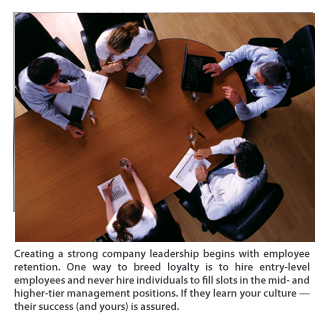Warrior Management

You are building an empire. You go to battle every day fighting to gain larger market share, defeat your competitors and capture new customers. The obstacles you encounter as a business owner are similar to the challenges that world conquerors faced centuries ago. What principles did world conquerors use to build their empires? How can those lessons be used to further your business success?
Genghis Khan’s approach to world domination was based on following a series of warrior management traits — operating tenets that formed the foundation for his success. Not surprisingly, these same traits can be used to achieve business success. Getting past the savagery that marked Genghis Khan’s reign, his structured approach to gaining world domination was simple, direct and replicable.
In fairness, the history of Genghis Khan portrays a brutal individual. But beyond the savagery of his methods, he employed an effective framework that continues to be emulated today by successful businesses. As a small business, you are in a position to effectively implement many of the warrior management traits. As Genghis Khan was known to reflect, numerical superiority never won a battle — cunning and effective operations were key to growing his empire.
Adapt (to the Ever-changing Environment)
A mid-sized utility contracting firm contemplated their strategic initiatives for the coming year — a year marked with the lowest expected revenues in a generation. The managers, filled with bravado, sought to better their peers by offering measurable objectives for the year that were outlandish given the current market conditions. After boasts of 10-, 25- and 100-percent growth were offered as targets for the year, a quiet voice of reason came from the back of the room: “I hope we don’t go out of business.” The room became hushed and the reality of the market environment hit home. Survival, not growth, was the objective for the year.

Every business encounters uncontrollable environmental constraints. These constraints come in the form of laws, fuel costs, competition, the economy and labor costs. You can’t change them and ignoring them can bankrupt your business. The prudent approach is to embrace these constraints and leverage them as part of your business solution. After all, the same constraints that affect your strategies are being felt by every other business in your industry.
Focus (on Achieving One Objective at a Time)
Visiting a small firm in the eastern United States, I happened to ask for a copy of their recent strategic planning document. The owner found a copy on his bookshelf, blew off the collected dust and handed it to me. As I thumbed through the beautifully bound plan, I noticed that the firm had documented a series of 156 tasks to be completed during the year. When I asked how many had been accomplished, the owner shrugged his shoulders and indicated that none of them had been completed. The firm didn’t know where to start.
Genghis Khan followed the premise of achieving one objective at a time. With limited warrior resources, it didn’t make practical sense to send fragments of legions into multiple battles simultaneously. Using only partial resources to fight, the natural outcome would be a huge loss of personnel with little, if any, progress to show for their efforts. It was better to utilize his resources to conquer one “enemy” at a time — ensuring success, as well as protecting his warrior resources for the next conquering initiative.
As a business owner, you wrestle with the issues of adding new employees, increasing the diversity of your offerings, changing pricing structures and seeking new distribution channels, in addition to a myriad of other changes to your business dynamics. Ask yourself the simple question: What three activities must I complete in 2009 to move my business forward? The answer forms your battle plan — the foundation of your next year’s success.
Unite (Your Workforce)
A small architectal and design firm has the enviable statistic of losing only one employee over the last five years — a remarkable employee retention rate. It turns out that the firm only hires entry-level employees right out of the university and never hires individuals to fill slots in the mid- and higher-tier management positions. The rationale is simple — individuals right out of the university don’t have any bad habits that need to be broken. They are a clean slate that can be taught the business consistent with the firm’s policies and practices.
Conversely, individuals who have already accumulated practical experience come to the firm with baggage that can never seem to be undone.
Genghis Khan followed a similar philosophy that forbade any personnel transfers between his officer’s battalions. His concern was that if individuals believed that they could transfer between officers, there would be no loyalty to any single battalion. It was plausible to assume that in time of battle these individuals would seek a more comfortable existence and try to remove themselves to another less-risky environment.
This warrior management trait should not be viewed as an impediment to transferring individuals in your firm between practice managers. It should, however, point out the value of obtaining talent to fill the junior levels in your firm and actively growing them to assume greater levels of authority over time. If they learn your culture, their success (and yours) is assured.
Share (the Spoils)
A small contracting firm wrestled to implement a performance-based compensation system. The problem wasn’t the system but the insecurities of the owner. He believed that every employee should be limited to the amount of compensation they could earn — regardless of their contribution. He failed to realize that providing unlimited upside incentives to a high performer ensured a greater value return to him.

The lesson is simple — don’t bind the compensation of any employee in such a way that it limits their performance. Even in this day and age where “life balance” is often used to reflect the boundaries between work and personal time, high performers still realize the value of achievement and, in most cases, are willing to work to obtain higher levels of compensation. You should be excited to find these employees and, in turn, provide them with a framework for unlimited rewards.
Speed (of Execution)
Small businesses share a trait that larger businesses cannot emulate — speed of execution. Most small firms pride themselves on being flexible, nimble and able to leverage market opportunities quickly. Larger corporations, because of their bureaucracy, fall prey to analysis paralysis and are often beaten to the market by smaller competitors. Once in the market, the smaller firms are able to gather market share quickly, putting the larger firms at a disadvantage.
Genghis Khan recognized that opportunity was fleeting. Infinite patience was necessary to ensure that all the attributes for success were in place prior to leading an offensive charge. Once in place, the window of opportunity was small, necessitating quick action on his part. Much of his success was based on his speed of execution — to immediately act when all the pieces fell into place.
What attributes need to be present for your business to succeed? When is action warranted or, conversely, when is patience prudent? As a business owner, you need to be ready to move quickly to leverage nuances
in your market. Waiting on the sidelines only allows your competition to make their move.
Today, you sit atop your own empire. What direction will you take? How will you effectively leverage your marketplace? Many of you will continue to follow the lessons learned through traditional business methods — the same ones followed by larger, more lethargic, corporations. You have a choice, moreover, a challenge to discard your present mentality and adopt a historic perspective – that of a warrior. Are you ready to be a conqueror?
Brad Dawson is the Managing Director of LTV Dynamics and has over 28 years of management and financial consulting experience. He is a frequent lecturer to international entrepreneurial businesses and serves as a contributing writer to several national and international business and leadership magazines. To find out about the other 17 warrior management traits contact him at BLDawson@LTVdynamics.com

Comments are closed here.